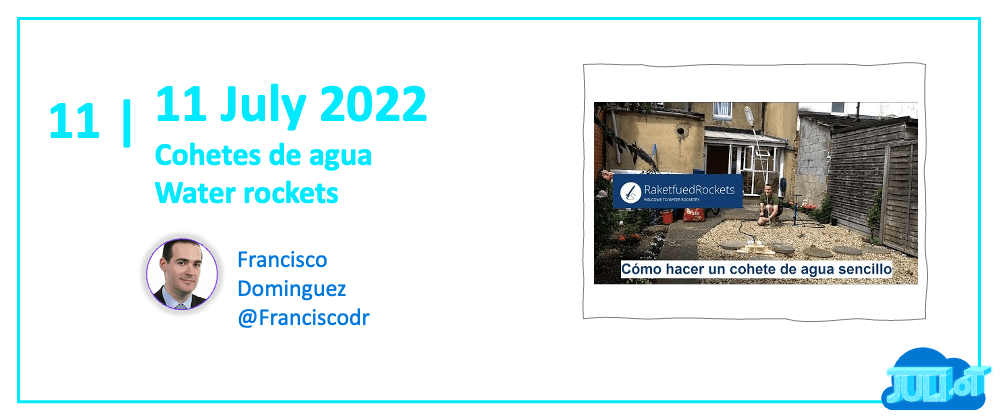This year we are also celebrating #JulIoT - JulyOT in Spanish!
Cohetes de agua
¿Quieres ver o incluso entrar en la carrera espacial? Ahora puedes con los cohetes de agua automáticos. Hasta 100 metros de altura, captura de datos y despliegue automático de paracaídas con Arduino.
Tutorial cómo crear un cohete de agua sencillo
Os presento el tutorial de cómo hacer un cohete de agua sencillo. Incluye cohete y plataforma de lanzamiento. Suena complicado pero es fácil de hacer, volar y mantener.
No esperes que llegue muy alto, pero sí te asegurará horas de diversión mientras lo montas y luego volándolo. Aquí el vídeo que me inspiró de Raketfued Rockets.
Y aquí la lista de materiales traducida y con fotos de ejemplo para que se vea más claro
Tienes el instructable aquí (en inglés).
Ojo: vuélalo en un sitio despejado y dónde no haya gente. Si estás cerca mientras lo manejas hazlo con precaución.
Videos from the water rocket (I) Oxford (UK)
Finally the rocket flies high, and I installed a camera onboard, so we can see more things.
Videos from a water rocket II. Oxford (UK)
Here is the second part of the water rocket test! We've got some progress on the electronics and new videos, don't miss them!
Automatic parachute for water rocket
Finally we have a parachute that works! Well it only worked in 1 out of 4 attempts. Why? How is it working? The mechanism is very simple, with Arduino and a few components. I left everything explained in this video.
New automatic parachute system
Here we have the new version of the water rocket, with all the secrets and improvements on:
- the launchpad, to avoid pressure leakage.
- The fins for a more straight flight.
- The automatic parachute system, more reliable and lighter.
- The navigation software, for a more accurate detection of launch, apogee, and data storage in the Arduino EEPROM.
Visita al Museo de la Ciencia de Londres. Cohetes
Aquí os traigo un mini tour por uno de los museos que más me gustan: el Museo de la Ciencia de Londres. No es una pasada, sino lo siguiente! Me centro especialmente en el apartado de cohetes porque es la parte que más me gusta. Pero si te gusta la ciencia, la ingeniería o simplemente curiosear cómo funcionan las cosas encontrarás de todo. A ver, cosas prácticas para saber:
- Entrada gratis. Piden donativo pero si no quieres no das. Recomiendo dar algo siempre para el mantenimiento del museo. Comprando cosas en su tienda, que es una pasada también ayudas.
- Mejores horarios: en general primera hora (a las 10) o a última hora (a las 16h). Cierran a las 18h. Te aconsejo mirar el horario en Google Maps porque te suele decir lo concurrido que está en el momento que quieres ir.
- Tienes un simulador en la planta baja de las misiones Apolo que está bien: se mueven los asientos y es 3D. En la última planta también hay simuladores chulos.
(One of the) First in the World landing gear for water rockets
Finally I could make it. This is a great advancement of a landing system for a water rocket. (Thanks for your comments correcting me. If you did it before or in other way, please let me know. As you see I corrected the title too to be fair 😉 ).
As you can see there are already some progress like:
- the self deployed legs.
- the automatic mechanism, entirely design from scratch.
I did already some reliability tests, with all the parts integrated. Next steps are to connect the servo mechanism to the Arduino and program the system.






Latest comments (0)